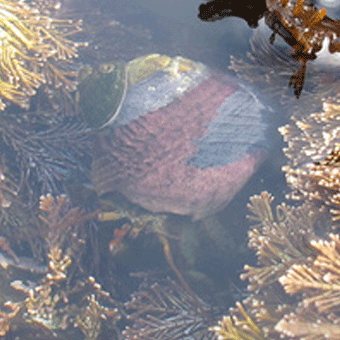
What would you do with a soft tail?
A hermit crab slips its soft abdomen into an empty shell. The crab is protected while nestled deep inside, sometimes nestled too deep to see. The delicate abdomen is gently curved to fit snuggly in the shell; trying to pull the crab out could rip it in half.
As the hermit crab grows, it needs larger shells. A large hermit crab in a too-small shell won’t be able to withdraw all the way into the shell, leaving it exposed to predators and thieving relatives. A small hermit crab in a very large shell may be able to withdraw so far that you wouldn’t be able to see it—even a shell that looks empty may not be.
Leaving shells on the beach leaves more hermit crab housing!
A shell is a shell?
Empty black turban snail shells are favored homes for hermit crabs; these durable shells can protect many generations of hermits long after the snail that made the shell has died.
Undisturbed, hermit crabs jostle and jerk along the tidepool bottom and through the seaweeds: slow moving snail shells are probably actually snails, fast moving snail shells are probably hermit crabs inside old snail shells.
Check out the short video clip of a hermit crab by clicking on the video camera icon on this page.
